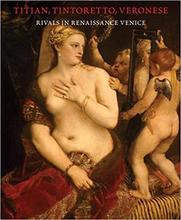More about Sacred and Profane Love
- All
- Info
- Shop

Contributor
Titian's Sacred and Profane Love makes sensuality and sexuality accessible in a way that epitomizes the Republic of Venice, which lasted until 1797 CE.
Today, despite boundary-pushing explorations of sexuality by the likes of Marina Abramović and the late Carolee Schneemann, people still think of "high" art as an intellectual vocabulary for "dealing with issues." This unimaginative approach has dominated the voluminous criticism of Sacred and Profane Love: what Platonic themes do the two women "represent"? There is nothing to prove, however, that these two women, one clothed and one naked, with a baby in between, represent anything specifically, except for the need of people to witness and appreciate nudity.
This simple possibility has raised the hackles of many people, such as the novelist Julio Cortázar, who suggested that Sacred and Profane Love is the work of a "pervert." Good heavens my oh me! While Cortázar's view is extreme, there is something in Sacred and Profane Love that anticipates and almost lays the foundation for today's behemoth of the porn industry: the "two women" in the image look identical, and are probably the same woman.
Over a period of three hundred and fifty years, at least eighteen authors gave different titles to the painting, and their suggestions say more about them than they do about the painting itself. It also makes you wonder, when did it become unacceptable to give your own title to a painting? Can we retitle the Mona Lisa as That Painting of the Smiling Woman that Napoleon Liked a Lot? If enough people accepted it, there is no reason why not! Strangely, the obsessive retitling of Sacred and Profane Love shows that no single person or group - not the artist, nor the maintainer of the work - has the ultimate authority to choose a title.
Although Titian had no involvement with the painting's title, which someone tacked on over a century later, the title highlights the doubling effect which is a primary sexual fantasy for many men who are attracted to women. On the left side is the woman clothed in a wedding dress, presentable to the community and the extended family, and there she is again on the right side, without the dress. There is a sense of discovery in the juxtaposition of the two images: the play of nice and naughty, and all the ensuing stereotypes. Given that the painting was commissioned by the Grand Chancellor of the Venetian Republic, it seems that such an image fulfilled a social and even a political function for the Venetian people: while critics would say that sexually arousing images can inflame the passions and cause unrestricted sexual activity, another view is that the consumption of arousing images can relieve the libido. It's most important how people behave toward one another, and we simply haven't proven whether the presence or absence of nude women in art causes good or bad behaviors.
In Irish parliament, a politician used the painting as an example of the excesses of a bill designed to sanitize art: "the lawyers who drew up the Bill...should study...Titian's Sacred and Profane Love, and ask themselves if there is no one it could not incite to "sexual passion"...are we prepared to exclude such art from Ireland and to sail in a ship of fools…?"
Sources
- Brilliant, Richard. My Laocoön: Alternative Claims in the Interpretation of Artworks. Berkeley: University of California Press, 2000.
- Brown, Beverly Louise. Art and Love in Renaissance Italy. New York: Metropolitan Museum of Art, 2008.
- Feal, Rosemary Geisdorfer, and Carlos Feal. Painting on the Page: Interartistic Approaches to Modern Hispanic Texts. Albany, NY: SUNY Press, 1995.
- Friedlander, Walter. "La tintura delle rose (the Sacred and Profane Love) by Titian." The Art Bulletin 20, no. 3 (Sep., 1938): 320-321, 323-324.
- Mayer, August L. "Niccolò Aurelio, the Commissioner of Titian's 'Sacred and Profane Love.'" The Art Bulletin 21, Iss. 1 (1939): 89.
- Standish, Peter. Understanding Julio Cortázar. Columbia, SC: University of South Carolina Press, 2001.
- Yeats, William Butler. The Collected Works of W.B. Yeats Vol X: Later Article: Uncollected Articles, Reviews, and Radio Broadcasts Written After 1900. New York: Simon & Schuster, 2010.
Featured Content
Here is what Wikipedia says about Sacred and Profane Love


Sacred and Profane Love (Italian: Amor Sacro e Amor Profano) is an oil painting by Titian, probably painted in 1514, early in his career. The painting is presumed to have been commissioned by Niccolò Aurelio, a secretary to the Venetian Council of Ten, whose coat of arms appears on the sarcophagus or fountain, to celebrate his marriage to a young widow, Laura Bagarotto. It perhaps depicts a figure representing the bride dressed in white, sitting beside Cupid and accompanied by the goddess Venus.
The title of the painting is first recorded in 1693, when it was listed in an inventory as Amor Divino e Amor Profano (Divine love and Profane love), and may not represent the original concept at all.
Although "much ink has been spilt by art historians attempting to decipher the iconography of the painting", and some measure of consensus has been achieved, basic aspects of the intended meaning of the painting, including the identity of the central figures, remain disputed.
Check out the full Wikipedia article about Sacred and Profane Love













